Itinerary edited by UNIVERSITY OF PERUGIA 

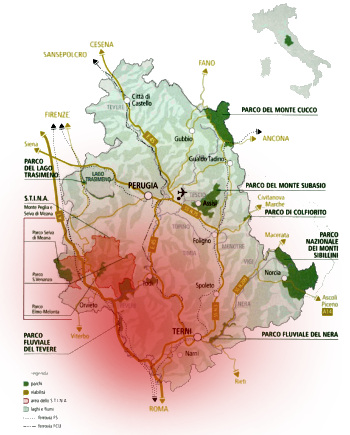
Images of the concerned environment:
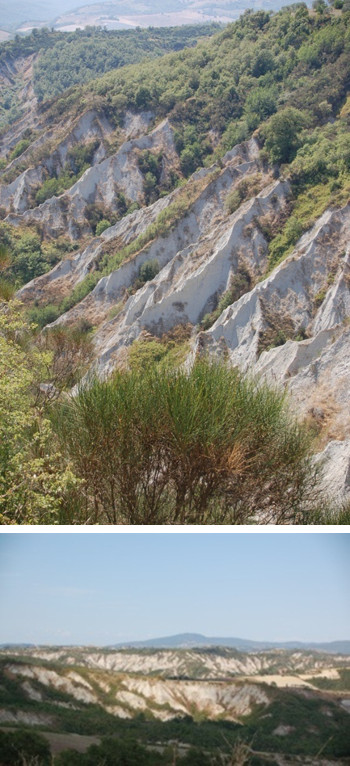
There are unique environments in south-western Umbria, in the vast hilly stretches that rise along the borders with Tuscany and Lazio, which feature the distinctive morphological and ecological features that characterize areas with ravines.
In these expanses, profoundly shaped by the erosion of soft substrates of ancient marine clays and sands, which date from the Pliocene era, caused by the sun, wind, and water, special vegetative associations and wildlife communities of great naturalistic interest have developed.
The harsh and unstable configuration of areas with gullies and badlands makes them difficult to colonize and use for agriculture and construction. This has preserved these environments from excessive anthropic exploitation, making them reservoirs of biodiversity capable of acting as “natural repopulation centres” in relation to the surrounding territorial contexts, which for the most part consist of agricultural crops and pastures. Furthermore, the proximity of these areas with the more thermally favourable inland Tuscan-Lazio regions, which offer a mild Tyrrhenian climate, has also favoured the spread of plant species and largely Mediterranean animals, which are absent or very scarce in the rest of Umbria.
Typical species
European bee-eater (Merops apiaster)
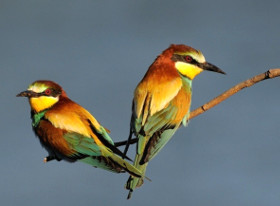
These small Coraciiformes (28 cm in length, weighing 50 g) are one of the most colourful examples of local birdlife, the bright colours of their plumage representing a true chromatic “ambassador” of the rich and varied fauna of the tropics on European soil.
Characterized by its elegant and slender form, the European bee-eater has long wings and a tail with an elongated and pointed central quill, which makes it a very skilful flier. It has a rather long, sharp narrow beak, perfect for capturing the insects on which it feeds, as it hunts them in aerobatic flight. This bird has a very colourful plumage, with a chestnut brown-reddish upper body, and a turquoise lower body, bright green aquamarine wings and tail, and a vivid golden yellow chin and throat, delimited by a thin black collar.
Belonging to a family, the Meropidae, of strictly tropical Afro-Asian origin, the common European bee-eater is present across much of southern Europe in the spring and summer months, above all in the hot regions of the Mediterranean climate, from the Iberian Peninsula to the Balkans and Asia Minor. They favour evergreen maquis alternating with sunny expanses of grassland, the garrigue, the steppes dotted with low bushes, and the banks of rivers and streams with steep sand and clay banks, where they dig narrow tunnels, pecking with their beaks, at the bottom of which they lay their eggs. A migratory species, in the late summer it leaves the nesting territories of southern Europe to spend the winter in the savannahs and woodlands of tropical Africa, home to many other local species belonging to the same genus.
In Italy the European bee-eater has spread across many Mediterranean and sub-Mediterranean climate areas, above all along the Tyrrhenian coast of the Maremma, Tuscany and Lazio, and milder inland areas. In Umbria it is mainly present, with several nesting colonies, in low-hilly areas in the south-west of the region, where the Tyrrhenian winds add a Mediterranean warmth to the local climate, and the clay hills with their typical gully formations and sparse shrub thickets, rich in insects, offer ideal living environments and abundant food sources.
European roller (Coracias garrulus)
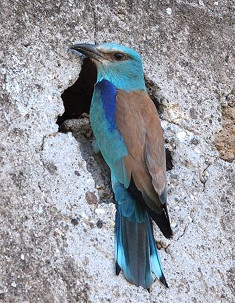
This medium to large sized Coraciiform (30 cm in length, weighing 140 g) is rather heavily built, in comparison with the smaller and more slender European bee-eater (Meropsapiaster). It is the ornithic species with the most colourful plumage, adding a tropical flavour to European birdlife. The European roller presents a plumage with dorsal parts of a warm cinnamon colour, and a head, throat, lower body and tail that are bright turquoise. Its wide wings, though mostly turquoise, are characterized by black flight feathers and coverts, with green-bluish and blue-violet hues.
Belonging to a genus that is very well represented in the tropical Afro-Asiatic regions, this species is widespread in much of southern Europe in the spring and summer months, and migrates to its favourite wintering areas in the savannahs of tropical Africa in the autumn. In Mediterranean regions it prefers open spaces, sunny grasslands with shrubs and scattered trees, sparse woodland, and bright, wooded pastures, where it hunts large insects, reptiles, and small mammals, such as rodents and insectivores, with great skill. It prefers to nest in cavities in large old trees or fractures in rock walls. It can also nest in old masonry in rural buildings.
In Italy the European roller is mainly present in the warmer Tyrrhenian regions, while it can also push into inland areas with a mild climate.
In Umbria the European roller is quite rare, and is mostly limited to the south-west areas of the region, on the border with Tuscany and Lazio, where it tends to frequent the low argillaceous and sandy hills, which are still partially covered with shrubs and tree-lined pastures.
The short-toed snake eagle (Circaetus gallicus)
Go to ICCD catalog cards
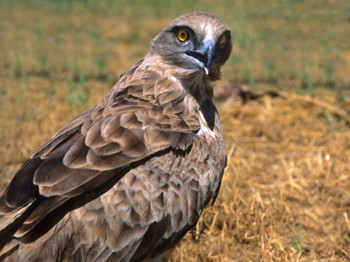
This majestic falconiform, of considerable size (65/67 cm in length, weighing 1750/1860 g), is characterized by a rather robust body, with a large round head. It has grey brown upper plumage, and a white lower body, with brown spots. The long broad wings are subtly striped at the bottom, and the light-coloured tail has 3/4 large dark transverse bars, which are clearly visible in flight.
The short-toed snake eagle is widespread in most areas of the temperate-hot climate of Eurasia and North Africa, above all in the Mediterranean regions, where it prefers sunny and bright open spaces, vast grassy expanses with scattered bushes, rocky scrubland, arid steppes, and pastures on steep hills or mountain slopes, with rocky outcrops, which are favourable for nesting and the formation of ascending currents. It mainly feeds on reptiles, especially snakes (hence the name snake eagle, or aguilaculebrera in Spanish), which it hunts by gliding and hovering at a low height over the arid expanses, and then rapidly swooping on its prey. Occasionally it also feeds on large insects, amphibians, and small mammals. It nests in the spring, building rough nests with twigs and branches on top of large trees, or between the bushes that cling to steep rock faces.